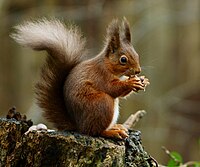
Conservation of genetic uniqueness in remaining populations of red squirrels (Sciurus vulgaris L.) in the South of England
Sign Up to like & getrecommendations! Published in 2019 at "Ecology and Evolution"
DOI: 10.1002/ece3.5233
Abstract: Abstract The Eurasian red squirrel (Sciurus vulgaris) is an emblematic species for conservation, and its decline in the British Isles exemplifies the impact that alien introductions can have on native ecosystems. Indeed, red squirrels in… read more here.
Keywords: red squirrel; conservation genetic; conservation; red squirrels ... See more keywords

The implications of significant adenovirus infection in UK captive red squirrel (Sciurus vulgaris) collections: How histological screening can aid applied conservation management
Sign Up to like & getrecommendations! Published in 2018 at "Mammalian Biology"
DOI: 10.1016/j.mambio.2017.10.003
Abstract: Abstract Conservation trans-locations using captive bred red squirrels (Sciurus vulgaris) is increasing in the United Kingdom (UK). However, project managers are often unaware of the risk of pathological adenovirus (ADV) infection. In this study we… read more here.
Keywords: infection; conservation; captive red; red squirrel ... See more keywords

Zoonotic ecotype-I of Anaplasma phagocytophilum in sympatric wildcat, pine marten and red squirrel - Short communication.
Sign Up to like & getrecommendations! Published in 2022 at "Acta veterinaria Hungarica"
DOI: 10.1556/004.2022.00021
Abstract: Anaplasma phagocytophilum is the causative agent of granulocytic anaplasmosis in humans, dogs, cats, horses and tick-borne fever in ruminants. In Europe, its main vector is the tick species Ixodes ricinus. In this study, spleen and… read more here.
Keywords: wildcat; phagocytophilum; pine marten; red squirrel ... See more keywords